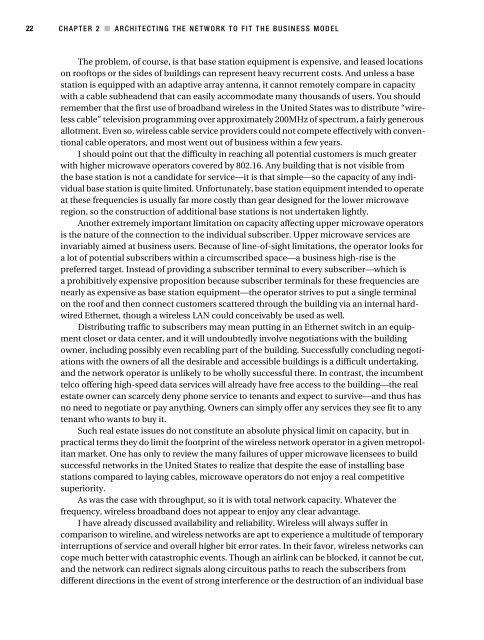WiMax Operator's Manual
WiMax Operator's Manual
WiMax Operator's Manual
Create successful ePaper yourself
Turn your PDF publications into a flip-book with our unique Google optimized e-Paper software.
22 CHAPTER 2 ■ ARCHITECTING THE NETWORK TO FIT THE BUSINESS MODEL<br />
The problem, of course, is that base station equipment is expensive, and leased locations<br />
on rooftops or the sides of buildings can represent heavy recurrent costs. And unless a base<br />
station is equipped with an adaptive array antenna, it cannot remotely compare in capacity<br />
with a cable subheadend that can easily accommodate many thousands of users. You should<br />
remember that the first use of broadband wireless in the United States was to distribute “wireless<br />
cable” television programming over approximately 200MHz of spectrum, a fairly generous<br />
allotment. Even so, wireless cable service providers could not compete effectively with conventional<br />
cable operators, and most went out of business within a few years.<br />
I should point out that the difficulty in reaching all potential customers is much greater<br />
with higher microwave operators covered by 802.16. Any building that is not visible from<br />
the base station is not a candidate for service—it is that simple—so the capacity of any individual<br />
base station is quite limited. Unfortunately, base station equipment intended to operate<br />
at these frequencies is usually far more costly than gear designed for the lower microwave<br />
region, so the construction of additional base stations is not undertaken lightly.<br />
Another extremely important limitation on capacity affecting upper microwave operators<br />
is the nature of the connection to the individual subscriber. Upper microwave services are<br />
invariably aimed at business users. Because of line-of-sight limitations, the operator looks for<br />
a lot of potential subscribers within a circumscribed space—a business high-rise is the<br />
preferred target. Instead of providing a subscriber terminal to every subscriber—which is<br />
a prohibitively expensive proposition because subscriber terminals for these frequencies are<br />
nearly as expensive as base station equipment—the operator strives to put a single terminal<br />
on the roof and then connect customers scattered through the building via an internal hardwired<br />
Ethernet, though a wireless LAN could conceivably be used as well.<br />
Distributing traffic to subscribers may mean putting in an Ethernet switch in an equipment<br />
closet or data center, and it will undoubtedly involve negotiations with the building<br />
owner, including possibly even recabling part of the building. Successfully concluding negotiations<br />
with the owners of all the desirable and accessible buildings is a difficult undertaking,<br />
and the network operator is unlikely to be wholly successful there. In contrast, the incumbent<br />
telco offering high-speed data services will already have free access to the building—the real<br />
estate owner can scarcely deny phone service to tenants and expect to survive—and thus has<br />
no need to negotiate or pay anything. Owners can simply offer any services they see fit to any<br />
tenant who wants to buy it.<br />
Such real estate issues do not constitute an absolute physical limit on capacity, but in<br />
practical terms they do limit the footprint of the wireless network operator in a given metropolitan<br />
market. One has only to review the many failures of upper microwave licensees to build<br />
successful networks in the United States to realize that despite the ease of installing base<br />
stations compared to laying cables, microwave operators do not enjoy a real competitive<br />
superiority.<br />
As was the case with throughput, so it is with total network capacity. Whatever the<br />
frequency, wireless broadband does not appear to enjoy any clear advantage.<br />
I have already discussed availability and reliability. Wireless will always suffer in<br />
comparison to wireline, and wireless networks are apt to experience a multitude of temporary<br />
interruptions of service and overall higher bit error rates. In their favor, wireless networks can<br />
cope much better with catastrophic events. Though an airlink can be blocked, it cannot be cut,<br />
and the network can redirect signals along circuitous paths to reach the subscribers from<br />
different directions in the event of strong interference or the destruction of an individual base
















